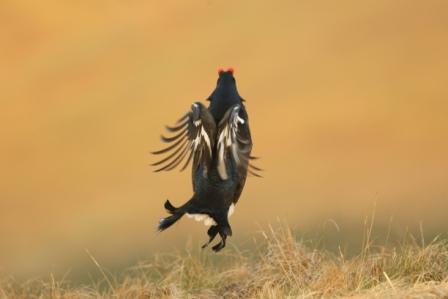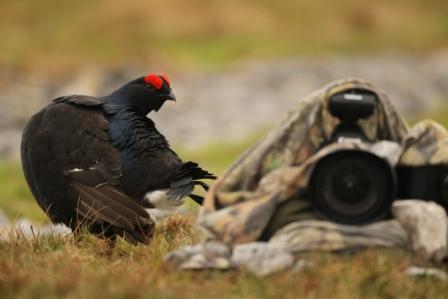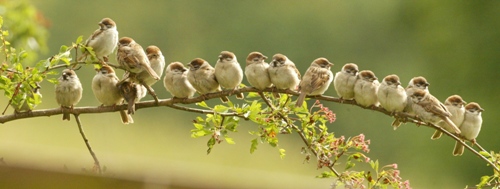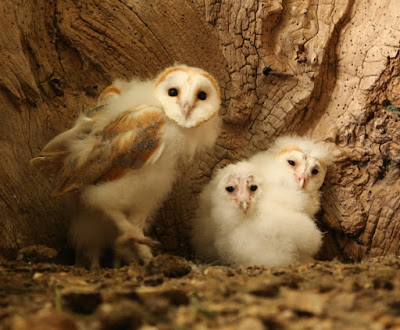The spectacular way these birds strut and display
their feathers was something I had
only seen once before. The display is spellbinding, if at times a little
comical. The males charge around with their curiously-curved tails fanned and
erect, wings spread and drooped, whilst making a loud continuous bubbling sound. Then, every now and then, they jump in the air and
call out before they resume circling again. It makes them look a bit like a
remote-controlled toy on the blink.
Meanwhile the dull-feathered females strut
nonchalantly through the commotion, occasionally fanning their tail feathers
and flirting with the males. For a new painting, I needed some really good
photographs to paint from. Black grouse lek in April and will use the same site
for the display over many years. It took a quite few phone calls to gain permission
from landowners to photograph at two sites, one near Hawes in the Dales and the
second in Upper Teesdale. At each location I found a local contact to help me
find the lek.
I set off to the Dales for a week at the beginning of April.
In the mating season, male and female black grouse gather early in the morning
for this communal courtship display and so it was important to get there well
before the action began each day. My guide was willing to let me use a hide he had built
close to the lek and I agreed to meet him at 4.45am at the bottom of the moor. I followed him up a stony track that seemed to lead
high up onto the moor into the clouds. It was 3°C and the wind blew so hard I was nearly
swept off my feet as I got out of the car.
The sky was black and it was only with the help of my
guide’s headlights that I could make out a canvas hide, braced against the
wind. The guy ropes were taut and the pegs had been weighed down with boulders
to keep the hide from flying off. As I clambered inside with all my camera gear and
began to set up, I was reminded of the first time I photographed black grouse
in North West Scotland. It was even colder there; I had snow showers to
contend with and, back then when I used film cameras, photographing in low
light was hard work. I was better prepared this time with warmer clothes
and digital cameras, but the weather was still against me.
I had just got the cameras onto the tripod when I
heard the unmistakeable ‘tcheway’ call of the black cock, shortly followed by
another one. It sounds a bit like a tyre being let out suddenly. Before long I
could see seven male birds, their white bottoms glowing in the gloom. As dawn approached, the noise climaxed. A hen was on
the horizon. She wandered through the lek, casually inspecting each male. They
were frantic to impress her and fights soon broke out amongst them.
But she sauntered nonchalantly through them and before
wandering to the edge of the lek and watching intently as another female
arrived on the scene – the females like to take their time before picking out
the fittest and strongest male.
It was a great morning, but by 8am all the action was
over and the grouse wandered off to feed. Once their tails are back down and no
longer fanned they look like an entirely different species, in fact more like you
would expect a grouse to look.
Over the next two days the weather got worse and when
I woke at 4am the rain was battering so hard against the window panes that I
decided to go back to sleep.
The next day I was awake at 4am as usual. The weather
wasn’t great but I didn’t want to lose a third day so I set off for the lek
anyway. As I started the drive high up into the hill clouds on the moor, the
wind and rain hammered against my windscreen.
But I stuck it out and by 7am the weather had improved a bit.
I got some quite good shots but was getting edgy; I
only had two days left and I still hadn’t got the pictures I wanted. I felt relieved when I watched the weather forecast
that night: things were set to brighten. On the fifth day of the trip, I woke even earlier than
usual, drew back the curtains and looked out of the window. I could see the
stars twinkling brightly, promising a clear day at last.
As I got into the hide it was still dark. There was
not a cloud in sight, but that strong wind was still there. The black
cock arrived at 5am and started to lek but as the sun came over the hill a short-eared
owl flew by. There was an explosion of whirring wings and in an instant all the
birds were gone. Luckily they reappeared 20 minutes later and started lekking
again.
I was pretty pleased with the result; so nice to see
them with a bit of sun on their backs, which brings out their iridescent sheen.
But again by 8am they were off.
I was due to travel back home on Saturday and decided
to give it one last go that morning. Again there was not a cloud in the sky but
for the first time all week the wind had dropped. As I waited in the hide in the dark I could hear the
haunting call of curlews ringing out across the moor followed by the signal
whistle of a golden plover. As the black cock arrived and also began to call, I
knew this would be the morning I had waited for. I had been up at 4am for four days and on the last day
of this trip it all seemed to be coming together.
Towards the end of the month I made my second trip,
this time to Upper Teesdale to a much bigger lek used by up to 20 males. This
time I had to get up at 3am to catch the lekking birds before dawn. Again I was plagued by bitterly cold winds, but the
sun came out each day and I was able to get more photographs – plenty to take
back to the studio and paint from.To me the black cock lek is one of the most unusual courtship displays I have seen. It is so spectacular you would expect it to be the dance of a tropical bird in an exotic rain forest, not a grouse on a bleak windswept moor in the North of England.
There are just 5,000 black grouse males left. Their decline is mainly due to dramatic changes to their moorland habitat. But the RSPB is restoring moorland reserves with heather and low shrubs for these beautiful birds to feed on. Find out how you can do to help save these beautiful birds at my exhibition: Saving Nature which opens at my gallery in Thixendale this Saturday, November 7th.
My latest paintings of endangered species from around the world will also be on show alongside all my wildlife photography and video clips from around the world. The exhibition is open daily and runs until Nov 29th.
There are just 5,000 black grouse males left. Their decline is mainly due to dramatic changes to their moorland habitat. But the RSPB is restoring moorland reserves with heather and low shrubs for these beautiful birds to feed on. Find out how you can do to help save these beautiful birds at my exhibition: Saving Nature which opens at my gallery in Thixendale this Saturday, November 7th.
My latest paintings of endangered species from around the world will also be on show alongside all my wildlife photography and video clips from around the world. The exhibition is open daily and runs until Nov 29th.












































